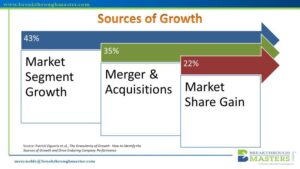Many of us are doing things we never thought possible. I spoke with a client this morning who said “We thought working remotely was something we would never do. Now we are good at it.” Leaders are seeing that what once served as constraint, our own belief in our ability to execute, is no longer a barrier.
Disruption has been happening all around us, enabled by technology, for years. Companies who lead in revenue today were often born as a result of disruption—think Amazon, Facebook, Google, Apple, etc. And while they have reached scale that most of us don’t even envy, they didn’t start out as giants. They are also all considered tech companies and most of us aren’t. But what worked for them had nothing to do with industry—it had to do with seeing opportunity.
What are some of the things these companies had in common?
- They met customer needs differently by paying attention to what was missing. Ask yourself what customers really want, not just how to sell more of what you make. How can you solve for things they don’t like and give them more of what they want? Julie Corbett, President and Founder of Ecologic Brands, found lighting in a bottle. Stymied while looking for an eco-friendly liquid laundry soup, she invented her own. “I had no background in packaging, I knew nothing about manufacturing,” says Corbett, “People think you need to be an industry expert to solve the problems but that’s not necessarily the case. It just takes a different lens.” (From Inc. May/June 2020). In fact, being an industry expert sometimes gets in our way because we are so engrossed in how things are done now we often don’t take the “outside-in” view where we look at problems through the eyes of the customer rather than the eyes of our operation.
- They integrated technology into products, services, and solutions. Technology is a great enabler. It runs our businesses (ERP), it tracks our relationships (CRM), and influences our ability to operate productively. However, if you are not using it to help you innovate your products or services you are likely sub-optimizing your potential.
- Artificial Intelligence: “Amazon was an early adopter of artificial intelligence and has injected it into almost every aspect of its business” says Brian Dumaine, the author of Bezomics, How Amazon is Changing Our Lives And What the World’s Best Companies Are Learning From It. AI is the future in many ways—even in conservative industrial B2B companies. In doing some research for a client, I saw an article about the impact of AI in energy production. “By managing data, companies are becoming more predictive about work processes, exerting better control over schedules, and minimizing emergencies that threaten to derail capital and maintenance investment,” says Sam Barnes, Industry Report 2020. One company in the construction sector has goals to dramatically influence metrics through AI—a 35% decrease in cost, a 50% drop in schedule duration, and a 60% increase in ROI.
- Digitizing Communication: Most business leaders I speak with are pretty sure that face to face customer meetings can’t be assumed going forward—ever. We have demonstrated we can work virtually, even if we don’t like it. And sometimes it works better—saving time and money. Savvy leaders are figuring out where to invest in virtual selling capabilities to augment their current sales processes.
- Services bundled with product: Many manufacturers have begun to realize that we are shifting to a service economy. Product differentiation is getting harder to achieve. In the information age, it is not hard for competitors to mimic even patented product, driving more and more similarity which puts pressure on margins. By bundling services with products into a seamless solution, such as offering smart products that track or support the function of a product, we have become more valuable for our customers. I see it demonstrated every day with my clients. Read more about how services drive growth here: https://www.breakthroughmaster.com/2019/03/services-not-products-drive-next-wave-of-growth-for-manufacturers/
- Think Big. 10% sounds like a lot, but planning for a 10% increase limits you from reaching 10x potential. We try to improve what we have or stretch our resources to accommodate opportunities rather than take a step back and re-imagine, re-invent and re-boot. To get to 10x (or even 2x) requires the organization to behave in a dramatically different way—maybe the core business becomes one division of several, or a local company goes national, or you acquire a technology platform developing a digital model of a traditional product. New possibilities open themselves up when not restrained by the past. 10% improves the company; 10x transforms it. What mindset do you wear?
- Follow where the market takes you. The industry you start in may not be the industry you stay in. Per the chart below, 43% of every growth dollar comes from market segment growth. As a colleague from Arkansas used to say, “Are you shooting when the geese are flying?”. Just because you have historically focused your business in a given sector doesn’t mean you can’t pivot and figure out how to apply your processes, your capabilities or your products to new markets. Apple and Amazon figured out how to take their capabilities across sectors. One client switched focus from the more traditional power industry to transportation which has seen growth in recent years. Healthcare has been a strong industry in the last few years, benefiting from new models and technology.

Time to pivot? Let’s talk about how you can get that done. mreynolds@breakthroughmaster.
